PC faxing with the MX340
| Article ID: ART106461 | | | Date published: 05/11/2015 | | | Date last updated: 08/15/2015 |
Description
Solution
 Sending a FAX
Sending a FAX
You can send faxes using the fax driver from applications that support document printing. You can only specify one fax recipient. You cannot send a fax to two or more recipients in one operation.
Only black and white transmission is supported.
1. Open the document you want to fax with an application (such as Word), and then click the Print command. (The command is Print... on the File menu.)
2. In Select Printer or Name in the Print dialog box, select Canon XXXX FAX, then click Print or 'OK'.
(XXXX stands for the model name of your printer.)
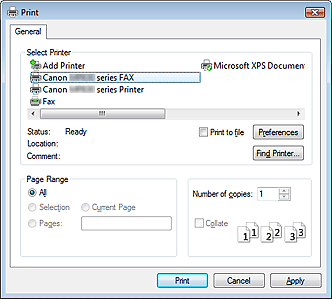
* Print dialog box in NotePad
Reference
You can specify the paper size and orientation for faxing in the setting dialog box. To open the setting dialog box, click Preferences or Properties (Windows 2000: Fax Options tab or Properties) in the Print dialog box.
3. Enter the name and fax number of the recipient, then click Add to Recipient List. Alternatively, click Display Address Book..., select a recipient from the recipient list, click Add to Recipient List, then click 'OK'.
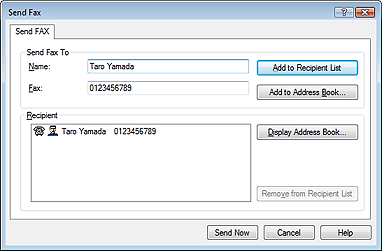
Reference
For details on valid characters, refer to the help for the fax driver.
You can register the recipient you entered to the address Book by clicking Add to Address Book....
See the section below for details on the address Book.
Creating an Address Book
4. Click 'Send Now'.
A confirmation message is displayed when transmission finishes.
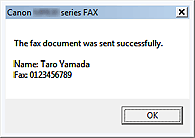
 Important
Important![]() If you cannot send a fax because of line failure etc., refer to User's Guide (On-screen Manual).
If you cannot send a fax because of line failure etc., refer to User's Guide (On-screen Manual).
 To Cancel a Fax
To Cancel a Fax
If you click Send Now in the Send Fax dialog box, the printer icon is displayed in the taskbar. Double-click this icon to display the list of fax jobs awaiting transmission or being sent.
Right-clicking a job and selecting Cancel stops transmission.
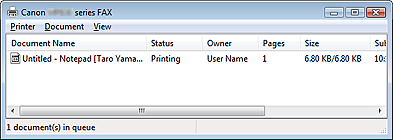
![]() Opening the Address Book for the First Time (Windows XP/Windows 2000)
Opening the Address Book for the First Time (Windows XP/Windows 2000)
In Windows XP/Windows 2000, when you open the Address Book for the first time, the Setup Windows Address Book dialog box will be displayed.

 To Create a Windows Address Book (WAB file) Exclusively for Faxing
To Create a Windows Address Book (WAB file) Exclusively for Faxing
Click Create new Windows Address Book file for MP., then click 'OK'.
You can also change the setting later so as to be able to use another Address Book. For details, refer to the help for the fax driver.
![]() To use an existing Windows Address Book
To use an existing Windows Address Book
Select this option if you do not create a new address Book file exclusively for faxing.
Click Select existing Windows Address Book file., select an address Book file from the list, then click 'OK'.
Using an existing Windows Address Book enables you to share it with other applications that use Windows Address Books. This option cannot be selected if there is no Windows Address Book file created.
 Important
Important
![]() For details on how to open the Windows Address Book (the default address Book of the operating system), refer to the help or manual for the applications that use Windows Address Book.
For details on how to open the Windows Address Book (the default address Book of the operating system), refer to the help or manual for the applications that use Windows Address Book.
Creating an Address Book
By using the address book, you can send a fax by simply specifying a recipient from it. You can register the recipient's name, fax number and other information in the address book.
Registering a recipient (WAB contact) in the address book
You can register an individual recipient (Contact) in the address book.
-
From the Start menu, navigate as follows:
-
Windows 7:
From the Start menu, select Control Panel > Hardware and Sound > Devices and Printers.
-
Windows Vista:
From the Start menu, select Control Panel > Hardware and Sound > Printers.
-
Windows XP:
From the Start menu, select Control Panel > Printers and Other Hardware > Printers and Faxes.
-
Windows 2000:
From the Start menu, select Settings > Printers.
-
-
Right-click the printer icon for Canon (model name) series FAX, then click Printing Preferences....
-
In the Canon (model name) series FAX Printing Preferences dialog box, click Address Book....
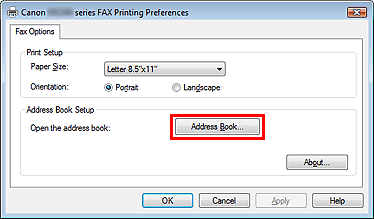
Opening the address book for the First Time (Windows XP/Windows 2000)
In Windows XP/Windows 2000, when you open the address book for the first time, the Setup Windows Address Book dialog box will be displayed.

Creating a New Windows Address Book (WAB File) Exclusively for Faxing
Select Create new Windows Address Book file for MP., then click OK.
You can also change the setting later so as to be able to use another address book. For details, see the help for the fax driver.
Using an Existing Windows Address Book
Select this option if you do not create a new address book file exclusively for faxing.
Click Select existing Windows Address Book file., select an address book file from the list, then click OK.
Using an existing Windows Address Book enables you to share it with other applications that use Windows Address Books.
This option cannot be selected if there is no Windows Address Book file created.
 Note
Note
-
In Windows 7/Windows Vista, you can register an individual recipient (Contact) in the address book folder (Windows Address Book) as an address book file (.contact file) which can be used in multiple applications. However, you cannot change the address book you use, as only one address book can be created per user.
To open the Windows Address Book, click the Start button, then click All Programs > Windows Contacts. (In Windows 7, select XXXX (user name) > Contacts from the Start menu.)
-
In Windows XP/Windows 2000, you can change the address book you use to another existing address book by clicking the Address Book Profile... in the Canon (model name) series FAX Printing Preferences dialog box. For details, see the help for the fax driver.
-
For details on how to open the Windows Address Book (the default address book of the operating system), see the help or manual for the applications that use Windows Address Book.
-
In Windows 7/Windows Vista, you can register an individual recipient (Contact) in the address book folder (Windows Address Book) as an address book file (.contact file) which can be used in multiple applications. However, you cannot change the address book you use, as only one address book can be created per user.
-
In the Address Book dialog box, click New.
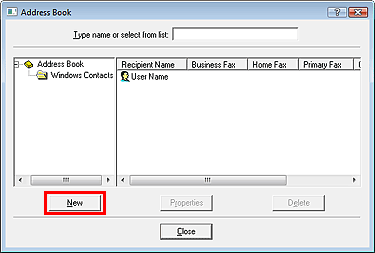
-
Click Contact in the New Entry dialog box, then click OK.
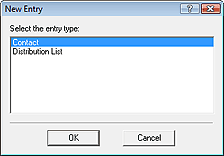
 Note
Note
- To send a fax, you can only specify one recipient. You cannot specify a Distribution List.
- To send a fax, you can only specify one recipient. You cannot specify a Distribution List.
-
Enter the First, Middle, and Last of the contact in the Name and E-mail tab (Name tab when using other than Windows 7/Windows Vista) on the Properties screen.
The recipient's name will be printed at the top of the fax received by the recipient.

-
Enter the fax number on the Home or Work tab, then click OK.
 Note
Note
-
You can also register a recipient by clicking the Add to Address Book... button on the Send Fax dialog box after entering the recipient.
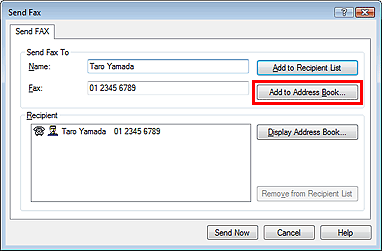
-
If you upgrade from Windows XP to Windows 7/Windows Vista, the address book you created in Windows XP may not be reflected in Windows 7/Windows Vista. In this case, open the address book in the following procedure and reflect the information to a new address book.
1. On the Windows taskbar, click the Start button, then click Control Panel > Appearance and Personalization > Folder Options.
2. Click the View tab of the Folder Options dialog box, select Show hidden files and folders in Advanced settings (In Windows 7, click the View in the Folder Options dialog box, then select Show hidden files, folders and drives in Advanced settings), then click OK.
3. On the Windows taskbar, click the Start button, click XXXX (user name), then double-click AppData > Roaming > Canon > MP5 to open the folder.
4. Double-click the ".wab" file.
The address book will be reflected in Windows Vista automatically.
-
You can also register a recipient by clicking the Add to Address Book... button on the Send Fax dialog box after entering the recipient.
-
In Windows XP/Windows 2000, you can use or import another Windows Address Book.
For details, see the help for the fax driver.
